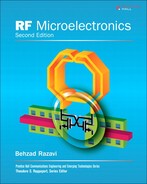Contents
CHAPTER 1 INTRODUCTION TO RF AND WIRELESS TECHNOLOGY
CHAPTER 2 BASIC CONCEPTS IN RF DESIGN
2.2.5 Cascaded Nonlinear Stages
2.3.1 Noise as a Random Process
2.3.3 Effect of Transfer Function on Noise
2.3.5 Representation of Noise in Circuits
2.4 Sensitivity and Dynamic Range
2.5 Passive Impedance Transformation
2.5.2 Series-to-Parallel Conversion
2.5.4 Loss in Matching Networks
2.7 Analysis of Nonlinear Dynamic Systems
2.8.1 Method of Nonlinear Currents
CHAPTER 3 COMMUNICATION CONCEPTS
3.2.2 Phase and Frequency Modulation
3.3.1 Intersymbol Interference
3.3.4 GMSK and GFSK Modulation
3.3.5 Quadrature Amplitude Modulation
3.3.6 Orthogonal Frequency Division Multiplexing
3.6 Multiple Access Techniques
3.6.1 Time and Frequency Division Duplexing
3.6.2 Frequency-Division Multiple Access
3.6.3 Time-Division Multiple Access
3.6.4 Code-Division Multiple Access
3.8 Appendix I: Differential Phase Shift Keying
CHAPTER 4 TRANSCEIVER ARCHITECTURES
4.2.1 Basic Heterodyne Receivers
4.2.2 Modern Heterodyne Receivers
4.2.3 Direct-Conversion Receivers
4.3.2 Direct-Conversion Transmitters
4.3.3 Modern Direct-Conversion Transmitters
CHAPTER 5 LOW-NOISE AMPLIFIERS
5.3.1 Common-Source Stage with Inductive Load
5.3.2 Common-Source Stage with Resistive Feedback
5.3.4 Cascode CS Stage with Inductive Degeneration
5.3.5 Variants of Common-Gate LNA
5.3.7 Reactance-Cancelling LNAs
5.6.2 Other Methods of IP2 Improvement
5.7.3 Differential and Quasi-Differential Pairs
5.7.4 Degenerated Differential Pair
6.1.3 Single-Balanced and Double-Balanced Mixers
6.2 Passive Downconversion Mixers
6.2.5 Current-Driven Passive Mixers
6.3 Active Downconversion Mixers
6.4.1 Active Mixers with Current-Source Helpers
6.4.2 Active Mixers with Enhanced Transconductance
6.4.3 Active Mixers with High IP2
6.4.4 Active Mixers with Low Flicker Noise
6.5.1 Performance Requirements
6.5.2 Upconversion Mixer Topologies
7.2.7 Alternative Inductor Structures
7.3.2 Effect of Coupling Capacitance
8.2.1 Feedback View of Oscillators
8.2.2 One-Port View of Oscillators
8.5 Voltage-Controlled Oscillators
8.5.1 Tuning Range Limitations
8.6 LC VCOs with Wide Tuning Range
8.6.1 VCOs with Continuous Tuning
8.6.2 Amplitude Variation with Frequency Tuning
8.7.3 Analysis of Phase Noise: Approach I
8.7.4 Analysis of Phase Noise: Approach II
8.7.5 Noise of Bias Current Source
8.7.6 Figures of Merit of VCOs
8.10 Mathematical Model of VCOs
8.11.2 Properties of Coupled Oscillators
8.11.3 Improved Quadrature Oscillators
8.12 Appendix I: Simulation of Quadrature Oscillators
9.2.1 Alignment of a VCO’s Phase
9.2.5 Frequency Multiplication
9.3.1 Phase/Frequency Detectors
9.3.5 Limitations of Continuous-Time Approximation
9.3.6 Frequency-Multiplying CPPLL
9.4.1 Up and Down Skew and Width Mismatch
9.4.3 Charge Injection and Clock Feedthrough
9.4.4 Random Mismatch between Up and Down Currents
9.4.5 Channel-Length Modulation
9.8 Appendix I: Phase Margin of Type-II PLLs
CHAPTER 10 INTEGER-N FREQUENCY SYNTHESIZERS
10.2 Basic Integer-N Synthesizer
10.4 Spur Reduction Techniques
10.5.2 Modulation by Offset PLLs
10.6.3 Choice of Prescaler Modulus
10.6.6 Injection-Locked Dividers
10.6.7 Divider Delay and Phase Noise
CHAPTER 11 FRACTIONAL-N SYNTHESIZERS
11.2 Randomization and Noise Shaping
11.2.3 Higher-Order Noise Shaping
11.2.4 Problem of Out-of-Band Noise
11.2.5 Effect of Charge Pump Mismatch
11.3 Quantization Noise Reduction Techniques
11.3.4 Multiphase Frequency Division
11.4 Appendix I: Spectrum of Quantization Noise
12.1.1 Effect of High Currents
12.1.4 Single-Ended and Differential PAs
12.2 Classification of Power Amplifiers
12.2.1 Class A Power Amplifiers
12.2.2 Class B Power Amplifiers
12.2.3 Class C Power Amplifiers
12.3 High-Efficiency Power Amplifiers
12.3.1 Class A Stage with Harmonic Enhancement
12.3.3 Class F Power Amplifiers
12.5 Large-Signal Impedance Matching
12.6 Basic Linearization Techniques
12.7.2 Polar Modulation Issues
12.7.3 Improved Polar Modulation
12.10.3 PAs with Power Combining
CHAPTER 13 TRANSCEIVER DESIGN EXAMPLE
